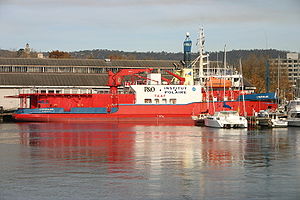Ywam Liberty
 Astrolabe berthed at Franklin Wharf in Hobart, Tasmania
| |
| History | |
|---|---|
| Name |
|
| Namesake | Astrolabe |
| Owner | P&O Maritime Services (France)[1] |
| Port of registry | Marseille, |
| Builder | Ferguson-Ailsa, Glasgow, United Kingdom |
| Yard number | 567 |
| Completed | 1 January 1986 |
| Identification | |
| Status | In service |
| General characteristics | |
| Type | Antarctic supply ship |
| Tonnage | |
| Length | 65.5 m (214 ft 11 in)[1] |
| Beam | 12.8 m (42 ft 0 in)[1] |
| Depth | 5.35 m (17 ft 7 in)[1] |
| Ice class | 1A Super[4] |
| Installed power | 2 × Mirrlees Blackstone 8MB275 (2 × 2,300 kW)[5] |
| Propulsion |
|
| Speed | |
| Capacity | 50 passengers[6] |
| Crew | 5 officers, 7 other crew[3] |
| Aviation facilities | Helipad |
Astrolabe is a French icebreaking research vessel. Her duties include bringing personnel and supplies to the Dumont d'Urville research station in Antarctica.[2][3][7][8][9] [10] The vessel has been making regular voyages between Hobart and the Dumont D’Urville research station for fifteen years. Astrolabe is among the smallest research vessels working in Antarctic waters.
The vessel is frequently serviced in the Tasmanian shipyard Southern Marine Shiplift in Launceston.[11] The yard's maximum ship displacement is 2150 Tonnes.[12]
History
1992 Northeast Passage
The vessel has also traversed the Northeast passage.[13] The European Space Agency reports a 1992 traverse "was the first civilian expedition through the NSR since the Russian revolution." Astrolabe was escorted on her transit by Russian icebreakers.
2013 Antarctic Ocean rescue mission
Astrolabe attempted to reach Akademik Shokalskiy, trapped by an outbreak of old glacial ice in the Antarctic Ocean. Astrolabe' didn't match Chinese research vessel Xuě Lóng's 6 nautical miles (11 km; 6.9 mi) from the trapped Russian ship, but got closer than the Australian Aurora Australis' 10 nautical miles (19 km; 12 mi). Withdrawing after encountering heavy ice, she subsequently supported further attempts by Xuě Lóng and Aurora Australis to reach Akademik Shokalskiy and rescue her passengers.[14]
Incidents
2005 man overboard incident

On January 27, 2005, a crew member was found to have gone overboard.[3] The missing crew member's body was found.
During the recovery of his body the second engineer's hand was seriously injured, and he was at risk of losing his thumb.[3] A report by the Australian Transport Safety Board concluded his injury would have been avoided if the block he was using to recover the ship's boat had been equipped with hand holds. The report noted that the deceased crew member was found with a high blood alcohol level. He had been seen to be depressed, prior to his death, and the report concluded he had jumped or fallen overboard under the influence of alcohol.
2010 Antarctica helicopter crash
On October 28, 2010, a Eurocopter AS350 helicopter which operated between the ship and the Dumont d'Urville Station crashed in bad weather en route to the station. All 4 on board were killed.[15]
References
- ^ a b c d e "L'Astrolabe (8418198)". BV Fleet. Bureau Veritas. Retrieved 2013-12-27.
- ^ a b "Infrastructures et moyens: L'Astrolabe". Institute Polaire. Archived from the original on 2007-11-18. Retrieved 2008-04-21. translation
- ^ a b c d e f "Independent investigation into the man overboard fatality and subsequent lifeboat accident on board the French registered Antarctic support vessel L'Astrolabe in the Southern Ocean 27 January 2005" (PDF). Australian Transport Safety Board. Retrieved 2008-04-21.
- ^ "L'Astrolabe / Bases et navires". institut-polaire.fr. 2012. Retrieved 1 March 2012.
- ^ L'Astrolabe. Australian Transport Safety Bureau. Retrieved 2013-12-27.
- ^ a b c L'Astrolabe. P&O Maritime. Retrieved 2013-12-27.
- ^
"SCAR Report No 16: Appendix 7". Scientific Committee on Antarctic Research. Retrieved 2008-04-21.
Potential cooperative studies can be established between the Australia, France. Ice breaker Astrolabe supplies yearly the Dumont D'Urville base which can do some geophysical work in the way back and the Marion D'Ufre, not an icebreaker has multibeam, side scan sonar and a long-45 m- piston coring system), Italy and the US.
- ^
"Research shows Southern Ocean wind currents weakening". Australian Broadcasting Corporation. February 18, 2008. Retrieved 2008-04-21.
Volunteers and crew on the French research vessel, L'Astoblobe have been measuring temperature and salinity during regular trips between Hobart and the French research base in Antarctica, over the past 15 years.
- ^ "Antarctic Astronomy Diaries 2002/03". University Of New South Wales. Retrieved 2008-04-21.
- ^
"The wind, climate change and the Southern oceans". Coastal Watch. Retrieved 2008-04-21.
Called SURVOSTRAL (Surveillance of the Ocean Austral), the joint Australian-French-US program has produced a 15-year dataset based on readings taken by the volunteers and crew of the 65-metre French ship, L'Astrolabe, on regular voyages between Hobart and the French base at Dumont D'Urville.
- ^ "Southern Marine Shiplift: photo gallery". Southern Marine Shiplift. Retrieved 2008-04-21.
- ^ "Southern Marine Shiplift: Repairs". Southern Marine Shiplift. Retrieved 2008-04-21.
- ^
"ICEWATCH - REAL-TIME SEA ICE MONITORING OF THE NORTHERN SEA ROUTE USING SATELLITE RADAR TECHNOLOGY". European Space Agency. Retrieved 2008-04-21.
The Nansen Environmental and Remote Sensing Center in Bergen, Norway first demonstrated use of ERS-1 SAR data for near real-time ice mapping in the NSR in August 1991, only a few weeks after the launch of the ERS-1 satellite. SAR derived sea ice maps were then sent by telefax to the French polar vessel L´Astrolabe during her voyage through the Northeast Passage from Norway to Japan (Johannessen et al., 1992). This was the first civilian expedition through the NSR since the Russian revolution. This demonstration was evaluated as very interesting by the captains and sea ice experts onboard the Russian icebreakers which escorted L'Astrolabe through the ice-covered parts of the route.
- ^ "American Morning". CNN TV. 2013-12-30.
- ^ "Antarctic chopper crash kills four". Herald Sun. 30 October 2010. Retrieved 30 October 2010.
